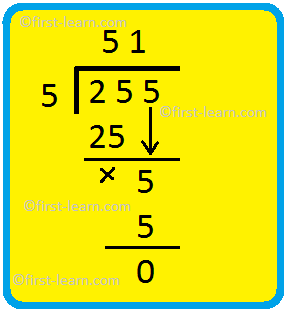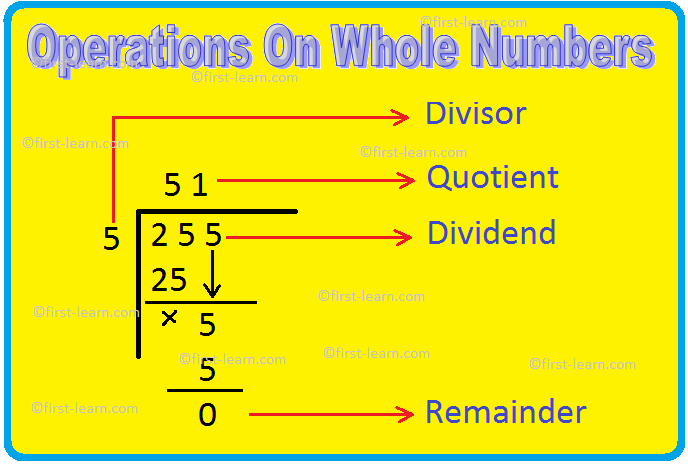Operations On Whole Numbers
Whole numbers are positive integers along with zero. They are all the natural numbers including zero. Hence we can say that all whole are natural numbers but natural numbers does not include zero hence all natural numbers are not whole numbers.
Whole Numbers = 0, 1, 2, 3, 4, 5, 6, 7, 8, 9, 10 and 11 ……………etc
Whereas, natural numbers =1, 2, 3, 4, 5, 6, 7, 8, 9, 10 and 11 ……………etc
There are four basic operations with whole numbers that is addition, subtraction, multiplication and division. The first operation with whole numbers is addition and the inverse operation of this is subtraction. Again, the inverse operation of multiplication is division.
Here are few examples showing four basic operation of whole numbers
ADDITION
Example:
Add: 23 and 25
T O
2 3
+ 2 5
4 8
Here in the ones column 3+5 = 8 and in tens column 2+2 =4. That gives the answer 48
SUBTRACTION
Example:
T O
9 2
(-) 5 0
4 2
In the ones column 0 is subtracted from 2 to get 2 and in the tens column 5 is subtracted from 9 to get 4
We can see that subtraction is an inverse of addition because if we add 50 + 42 we get 92. This is also done to check whether the answer is correct or not.
MULTIPLICATION
Example:
H T O
4 2 5
× 2
8 5 0
425 is the multiplier and 2 is the multiplicand. Now, 2 is multiplied first with 5 in the ones column to get 10. We cannot write 10 we will write 0 and 1 will be carried over in the tens column. Now in tens column again 2 is multiplied with 2 to get 4 and 1 is carryover of the ones place. Hence it becomes 4+1 =5. In hundreds place 2 is multiplied with 4 to get 8.
We can see over here that multiplication operation is nothing but repeated addition operation. Instead of multiplying 425 with 2 we can add 425 two times we will get the same number. 425+425 = 850. However, we opt for multiplication when the multiplier is a large number. For example; 425 × 9; if we do multiplication then we can find out the answer very easily but if we go for addition then we will have to add 425 nine times which becomes difficult and time-consuming.
DIVISION
Example:
255 ÷ 5
Answer: Quotient 51 and remainder 0
Here 255 is the dividend and 5 is the divisor. That is the number that is divided is called the dividend and the number by which it is divided (here 5) is called the divisor. The answer is the quotient and the balance remaining (here 0) is termed as remainder. First in the dividend one by one digit is considered. First considering 2 but 2 do not come in the tables of 5 and 2 is less than 5 so we have to consider 25. Now 5 × 5 =25 and then in the next step 5 is brought now and 5 multiplied by 1 is 5.
Here also we can see that division is the inverse of multiplication that is 51 × 5 = 255 (dividend)
From Operations On Whole Numbers to HOME PAGE
Recent Articles
-
What Is Plasma? | Blood Plasma | Proteins | Nutrients | Cholesterol
Nov 07, 25 10:29 AM
Blood is a mobile fluid which is a connective tissue and is derived from the mesoderm like cell any other connective tissue. Colour of blood is reddish and that flows inside the blood vessels by means… -
Disorders of Respiratory System | Tuberculosis | Pleurisy | Emphysema
Oct 28, 25 11:39 PM
Tuberculosis is very common disease and is caused by a type of bacteria called Mycobacterium tuberculosis. This disease causes different trouble in the respiration and infection of several parts of th… -
Regulation of Respiration | Respiratory Centres | Inspiratory Area |
Oct 14, 25 12:13 AM
Respiratory Centre is the area that controls the rate of respiration and it is observed to be located in medulla oblongata and pons. Respiratory Centre has the following will dispersed components like… -
Explain Transport of Gases | External Respiration | Tissue Respiration
Oct 09, 25 11:35 PM
In humans gaseous exchange is completed in the following ways the steps are - External Respiration or Breathing - Breathing in false taking in of Oxygen and giving out of carbon dioxide in the body. M… -
Kind and Number of Teeth | Location of Teeth in Mouth | Care of Teeth
Sep 11, 25 12:52 AM
Kind and Number of Teeth







New! Comments
Have your say about what you just read! Leave me a comment in the box below.